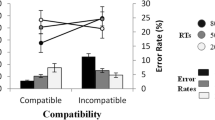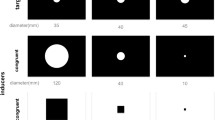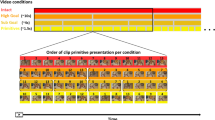Abstract
Neurophysiological observations suggest that attending to a particular perceptual dimension, such as location or shape, engages dimension-related action, such as reaching and prehension networks. Here we reversed the perspective and hypothesized that activating action systems may prime the processing of stimuli defined on perceptual dimensions related to these actions. Subjects prepared for a reaching or grasping action and, before carrying it out, were presented with location- or size-defined stimulus events. As predicted, performance on the stimulus event varied with action preparation: planning a reaching action facilitated detecting deviants in location sequences whereas planning a grasping action facilitated detecting deviants in size sequences. These findings support the theory of event coding, which claims that perceptual codes and action plans share a common representational medium, which presumably involves the human premotor cortex.

Similar content being viewed by others
Notes
One might wonder how our prediction that action planning facilitates perceptual processing fits with previous observations of action-induced blindness, that is, the finding that preparing a left- or right-hand action impairs the processing of a spatially compatible stimulus, such as a left- or right-pointing arrow (Müsseler & Hommel, 1997). The explanation is central for our present argument: We assume that planning an action binds the codes that represent this action’s features, which occupies these particular codes and makes them less available for other purposes like coding a perceptual event (the blindness effect; see Hommel & Müsseler, 2005). That is, occupying a code primes it and prevents it not from being further activated by other events, but it does prevent it (to some degree) from being bound with other features and to other representations. The new assumption we make here is that planning an action may not only activate the relevant feature codes but may also prime whole feature dimensions, such as size or shape in the case of grasping and location in the case of pointing. If true this would mean that any feature on the primed dimension would benefit from preparing a particular action. But please note that whether this benefit turns into a measurable behavioral advantage always depends on whether the particular feature is already bound to another event or not (Hommel, 2004)
References
Bekkering, H., & Neggers, S. F. W. (2002). Visual search is modulated by action intentions. Psychological Science, 13, 370–374.
Bundesen, C. (1990). A theory of visual attention. Psychological Review, 97, 523–547.
Byrne, R. W., & Russon, A. E. (1998). Learning by imitation: A hierarchical approach. Behavioral and Brain Sciences, 21, 667–684.
Craighero, L., Fadiga, L., Rizzolatti, G., & Umiltà, C. A. (1999). Action for perception: A motor-visual attentional effect. Journal of Experimental Psychology: Human Perception and Performance, 25, 1673–1692.
Elsner, B., Hommel, B., Mentschel, C., Drzezga, A., Prinz, W., Conrad, B. et al. (2002). Linking actions and their perceivable consequences in the human brain. Neuroimage, 17, 364–372.
Fadiga, L., Fogassi, L., Gallese, V., & Rizzolatti, G. (2000). Visuomotor neurons: Ambiguity of the discharge or ‘motor’ perception? International Journal of Psychophysiology, 35, 165–177.
Genzano, V. R., Di Nocera, F., & Ferlazzo, F. (2001). Upper/lower visual field asymmetry on a spatial relocation memory task. Neuroreport, 12, 1227–1230.
Hamilton, A., Joyce, D. W., Flanagan, R., Frith, C. D., & Wolpert, D. M. (2005). Kinematic cues in perceptual weight judgment and their origins in box lifting. Psychological Research, this volume.
Hannus, A., Cornelissen, F. W., Lindemann, O., & Bekkering, H. (2005). Selection-for-action in visual search. Acta Psychologica, 118, 171–191.
Hommel, B. (1998). Perceiving one’s own action—and what it leads to. In J. S. Jordan (Ed.), Systems theory and apriori aspects of perception (pp. 143–179). Amsterdam: North-Holland.
Hommel, B. (2004). Event files: Feature binding in and across perception and action. Trends in Cognitive Sciences, 8, 494–500.
Hommel, B. (2005a). How we do what we want: A neuro-cognitive perspective on human action planning. In R. J. Jorna, W. van Wezel, & A. Meystel (Eds.), Planning in intelligent systems: Aspects, motivations and methods. New York: Wiley. In press
Hommel, B. (2005b). Feature integration across perception and action: Event files affect response choice. Psychological Research, this volume.
Hommel, B., & Knuf, L. (2000). Action related determinants of spatial coding in perception and memory. In C. Freksa, W. Brauer, C. Habel, & K. F. Wender (Eds.), Spatial cognition II: Integrating abstract theories, empirical studies, formal methods, and practical applications (pp. 387–398). Berlin Heidelberg New York: Springer.
Hommel, B., & Müsseler, J. (2005). Action-feature integration blinds to feature-overlapping perceptual events: Evidence from manual and vocal actions. Quarterly Journal of Experimental Psychology (A). In press
Hommel, B., Müsseler, J., Aschersleben, G., & Prinz, W. (2001). The theory of event coding (TEC): A framework for perception and action planning. Behavioral and Brain Sciences, 24, 849–878.
Hommel, B., & Schneider, W. X. (2002). Visual attention and manual response selection: Distinct mechanisms operating on the same codes. Visual Cognition, 9, 392–420.
Hoshi, E., & Tanji, J. (2002). Contrasting neuronal activity in the dorsal and ventral premotor areas during preparation to reach. Journal of Neurophysiology, 87, 1123–1128.
Kornblum, S., Hasbroucq, T., & Osman, A. (1990). Dimensional overlap: Cognitive basis for stimulus–response compatibility—a model and taxonomy. Psychological Review, 97, 253–270.
Lupiáñez, J., Ruz, M., Funes, M. J., & Milliken, B. (2005). The manifestation of attentional capture: Facilitation or IOR depending on task demands. Psychological Research, this volume.
Milliken, B., & Lupiáñez, J. (2005). Repetition costs in word identification: Evaluating a stimulus–response integration account. Psychological Research, this volume.
Müller, H. J., Reimann, B., & Krummenacher, J. (2003). Visual search for singleton feature targets across dimensions: Stimulus- and expectancy-driven effects in dimensional weighting. Journal of Experimental Psychology: Human Perception and Performance, 29, 1021–1035.
Murata, A., Fadiga, L., Fogassi, L., Gallese, V., Raos, V., & Rizzolatti, G. (1997). Object representation in the ventral premotor cortex (area F5) of the monkey. Journal of Neurophysiology, 78, 2226–2230
Müsseler, J., & Hommel, B. (1997). Blindness to response-compatible stimuli. Journal of Experimental Psychology: Human Perception and Performance, 23, 861–872.
Oriet, C., Stevanovski, B., & Jolicoeur, P. (2005). Feature binding and episodic retrieval in blindness for congruent stimuli: Evidence from analyses of sequential congruency. Psychological Research, this volume.
Pickering, S. E., Gathercole, M., Hall, S. A., & Lloyd, S. A. (2001). Development of memory for pattern and path: Further evidence for the fractionation of visuo-spatial memory. Quarterly Journal of Experimental Psychology, 54A, 397–420.
Prinz, W. (1990). A common coding approach to perception and action. In O. Neumann, & W. Prinz (Eds.), Relationships between perception and action (pp. 167–201). Berlin Heidelberg New York: Springer.
Prinz, W. (1997). Perception and action planning. European Journal of Cognitive Psychology, 9, 129–154.
Rizzolatti, G., Camarda, R., Fogassi, L., Gentilucci, M., Luppino, G., & Matelli, M. (1988). Functional organization of inferior area 6 in the macaque monkey. II. Area F5 and the control of distal movements. Experimental Brain Research, 71, 491–507.
Rizzolatti, G., & Fadiga, L. (1998). Grasping objects and grasping action meanings: The dual role of monkey rostroventral premotor cortex (area F5). Novartis Foundation Symposion, 218, 81–95.
Rizzolatti, G., Riggio, L., & Sheliga, B. M. (1994). Space and selective attention. In C. A. Umiltà, & M. Moscovitch (Eds.), Attention and performance, XV. Conscious and nonconscious information processing (pp. 231–265), Cambridge: MIT Press.
Schubotz, R. I., & von Cramon, D. Y. (2001). Functional organization of the lateral premotor cortex: fMRI reveals different regions activated by anticipation of object properties, location and speed. Cognitive Brain Research, 11, 97–112.
Schubotz, R. I., & von Cramon, D. Y. (2002). Predicting perceptual events activates corresponding motor schemes in lateral premotor cortex: An fMRI study. Neuroimage, 15, 787–796.
Schubotz, R. I., & von Cramon, D. Y. (2003). Functional-anatomical concepts of human premotor cortex: Evidence from fMRI and PET studies. Neuroimage, 20, S120–S131.
Schubotz, R. I., & von Cramon, D. Y. (2004a). Brains have emulators with brains: Emulation economized. Behavioral and Brain Sciences, 27, 414–415.
Schubotz, R. I., & von Cramon, D. Y. (2004b). Sequences of abstract nonbiological stimuli share ventral premotor cortex with action observation and imagery. Journal of Neuroscience, 24, 5467–5474.
Schubotz, R. I., Friederici, A. D., & von Cramon, D. Y. (2000). Time perception and motor timing: A common cortical and subcortical basis revealed by fMRI. Neuroimage, 11, 1–12.
Shima, K., & Tanji, J. (2000). Neuronal activity in the supplementary and presupplementary motor areas for temporal organization of multiple movements. Journal of Neurophysiology, 84, 2148–2160.
Stoet, G., & Hommel, B. (1999). Action planning and the temporal binding of response codes. Journal of Experimental Psychology: Human Perception and Performance, 25, 1625–1640.
Tipper, S. P., Howard, L. A., & Houghton, G. (1999). Action-based mechanisms of attention. In G. W. Humphreys, J. Duncan, & A. Treisman (Eds.). Attention, space and action (pp. 231–247). Oxford: University Press.
Ward, R. (2002). Independence and integration of perception and action: An introduction. Visual Cognition, 9, 385–391.
Wenke, D., Gaschler, R., & Nattkemper, D. (2005). Instruction-induced feature binding. Psychological Research, this volume.
Wohlschläger, A. (2000). Visual motion priming by invisible actions. Vision Research, 40, 925–930.
Wolfe, J. M. (1994). Guided Search 2.0: A revised model of visual search. Psychonomic Bulletin and Review, 1, 202–238.
Acknowledgments
This research was supported by a grant of the Deutsche Forschungsgemeinschaft to BH (Priority Program on Executive Functions, HO 1430/8-2), and prepared during a sabbatical of SF at Leiden University.
Author information
Authors and Affiliations
Corresponding author
Rights and permissions
About this article
Cite this article
Fagioli, S., Hommel, B. & Schubotz, R.I. Intentional control of attention: action planning primes action-related stimulus dimensions. Psychological Research 71, 22–29 (2007). https://doi.org/10.1007/s00426-005-0033-3
Received:
Accepted:
Published:
Issue Date:
DOI: https://doi.org/10.1007/s00426-005-0033-3




